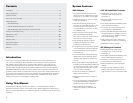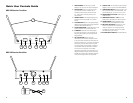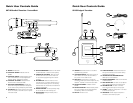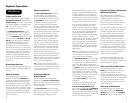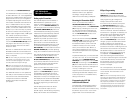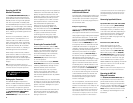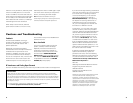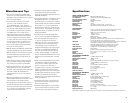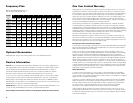16 17
Specifications
OVERALL SYSTEM PERFORMANCE
Operating Frequency Range 667.0MHz-696.7MHz (U.S.)
Freq. Synthesized (100 channels switchable) 300kHz/step
PLL system frequency stability <0.005%
Frequency Response 50Hz-18kHz +/-3dB
Dynamic Range 120dB
Harmonic Distortion <0.5%
Modulation FM (F3E) +/-25kHz normal, +/-75kHz max
Operating Range 150-250 feet typical, 500+feet max line-of-sight
UWS-100 RECEIVER
Receiver System Dual conversion Super Heterodyne with Digi-True Diversity
(dual antennas with optimum reception selected)
Selectivity 60dB, normal +/-75kHz offset
Image Rejection -70dB, minimum
Sensitivity -107dBm, normal
Spurious Rejection 65dB, normal
Mute Threshold Adjustable ( -65dBm to -95dBm)
Controls SELECT/AUTOSCAN, ASC Sync buttons, Power ON/OFF Rocker
Switch, MUTE level pot, VOLUME line level pot
LED Display Two Digits LED panel indicating selected Channel; RF A or B diversity
LED indicator; AF/Peak audio bi-color LED indicator
Audio Outputs LINE OUT UNBALANCED: adjustable line audio output
MIC OUT BALANCED: fixed mic level audio output
Output Impedance Unbalanced: 1k Ω and Balanced: for 600 Ω loads
Power Requirement 15VDC/0.4A
Antennas Dual permanently attached swivel antennas
Dimensions 6”W x 4.8”D x 1.5”H (15.3cm x 12.2cm x 3.8cm)
Weight 17oz (482g)
Housing Construction Metal
UH-100 HANDHELD TRANSMITTER
RF Output Power +14dBm (25mW typical)
Harmonic/Spurious Emission -50dBc normal
Impedance 3.0 kΩ
Controls Power OFF/STBY/ON, RF HI/LO and TX Lock switches
LCD Display Channels/Battery Levels/TX Lock
Antenna Type Integral
Battery Type 2 x AA alkaline batteries operation
Battery Life 8-10 hours typical
Dimensions 11”L x 2”D (28cm x 5.1cm)
Weight (w/o batteries) 8.3 oz (235g)
Housing Construction ABS Plastic
UB-100 BODYPACK TRANSMITTER
RF Output Power +14dBm (25mW typical)
Harmonic/Spurious Emission -50dBc normal
Input Impedance 5k Ω (Lavalier); 500 kΩ (Instrument)
Controls Power OFF/STBY/ON
Input Connector Locking 3.5mm mini-jack
LCD Display Channels/Battery Levels
Antenna Type External Removable
Battery Type 2 x AA alkaline or NiMH
Battery Life 8-10 Hours typical, alkaline
Dimensions 2.5”W x 1”H x 3.75”D (6.35cm x 2.54cm x 9.53cm)
Weight (w/o batteries) 3.1 oz (88g)
Housing Construction ABS Plastic
Specifications subject to change at any time without prior notice for purposes of product improvement
Miscellaneous Tips
The receiver antennas should be kept •
away from any metal surfaces whenever
possible as they can reflect away or shield
the incoming RF signal.
If the receiver’s volume control is set •
too high, it may overdrive the input
of the attached audio mixer, causing
distortion. Conversely, if the output is set
too low, the overall signal-to-noise ratio
of the system may be reduced, causing
noticeable hiss. If such noise occurs,
adjust the output level of the receiver so
that highest sound pressure level going
into the microphone transmitter causes
no input overload in the mixer, but permits
the mixer level control to operate in the
normal range (not too high and not too
low). This provides the optimal signal-to-
noise for the entire system.
Before inserting the batteries, ensure that •
they are inserted with the correct polarity.
Before operation, confirm that the receiver •
and associated transmitter are tuned to
the same frequency group and channel
number.
After making a receiver channel change, •
ensure that the corresponding change is
also made on the matching transmitter.
Use only new alkaline or fully recharged •
NiMH batteries. Do not use “general
purpose” carbon batteries. When batteries
are weak, replace all the batteries at
the same time. Do not mix new and old
batteries.
Position the receiver so that it has the •
least possible obstructions between it and
the transmitter. Line-of-sight is best!
During operation, the transmitter and the •
receiver should be as close as possible for
optimum results but never closer than 3 ft.
(1 m) as that may overload the receiver’s
input circuitry and cause noises.
If rackmounting the receiver, keep away •
from heat sources such as amps by
allowing enough space between them for
adequate ventilation.
For the best operation, the receiver should •
be placed at least 3 ft. (1 m) above the
ground and 3 ft. (1 m) away from a wall or
metal surface. The transmitter should also
be at least 3 ft. (1 m) from the receiver.
Keep antennas away from noise sources
such as motors, automobiles, neon lights,
signal processors, computers, as well as
large metal objects.
A receiver cannot receive signals from •
two or more transmitters simultaneously.
Turn the transmitter off when it is not •
in use. For longest life, remove the
batteries if the unit is not to be used for
a long period as the transmitters draw
a tiny residual current to maintain the
programmed settings, even when turned
off. Also, since batteries installed for a
long time can sometimes corrode and/
or leak, causing damage, it is generally
recommended that batteries be removed
whenever the transmitters are not being
used.
When using the bodypack for instrument •
use: Scratchy noises can sometimes
occur when an electric guitar with dirty
pots or connections is used with a
wireless system. Therefore, the supplied
capacitor provides first-order filtering of
the RF signal from the cord into the guitar
and eliminates virtually all scratchy noises.
Should your equipment still produce
scratchy noise, we suggest these steps to
eliminate problems:
1) Make sure all guitar volume and tone •
pots are clean and all contacts are solid.
This is very important.
2) Solder a 47pF capacitor across the pot •
to ground terminal of the guitar’s volume
and tone pots to provide extra filtering




